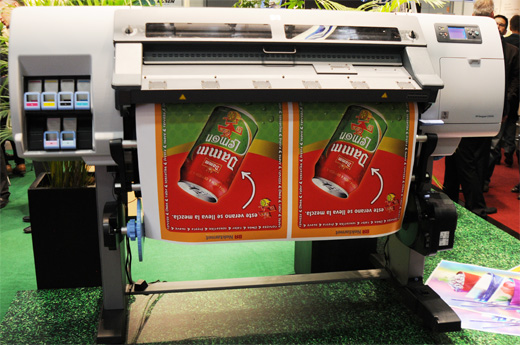HP Designjet L26500 latex ink printer replaces HP L25500 with an improved ink
The new HP Designjet L26500 will help remedy aspects of the original inks. And the HP Designjet L26500 tweaks the curing aspects of the original L25500.
The HP Designjet L26500 has been available to the public since October, but you had to sign an NDA to see it. Since we did not go to Barcelona for the (November) launch PR blitz, we had no NDA to sign, so we simply found all the info already on the Internet for the last two months.
At the launch of HP latex ink in smaller printers, VISCOM Duesseldorff 2009, I inspected both HP latex ink printers, the 42-inch and 60-inch HP Designjet L25500 models. There were modest crowds listening to the HP staff giving a talk to the audience in the aisles.
This latex ink technology had been shown under NDA since July and is now public. What most surprised people was the low price for the 60” version HP L25500, considering that the HP L65500 originally cost over $100,000. I asked several printshop owners what they expected the price to be. Their answers will be in the FLAAR Report on latex ink printers that. The actual price is lower than most people estimated.
 |
HP showcased the new HP Designjet L25500 latex ink printer - Model size: 42 in, at VISCOM Duesseldorf 2009. |
HP latex ink for car wrap? Can you use the HP L26500 or HP L65500 (HP Scitex LX850) for vehicle wrap?
In New Orleans, at SGIA, questions and curiosity was evident. Not many people fully understood the reality of latex ink. There is tons of HP literature, but either people are not reading it or not understanding it. So this is a perfect role for FLAAR, to translate the questions and document the answers.
Our first step was to visit a printshop that had the earlier large 104" HP Designjet L65500. I did this at Bright Blue Studies, outside Johannesburg, South Africa. Next step is to find, and inspect, the 42" or 60" L26500 latex ink printer. Now there is also info on the 104” HP Designjet L28500 since the end of October available widely on the Internet.
HP Designjet L26500 latex ink printer, 42-inch and 60-inch; are these viable replacements for eco-solvent printers? But what about Sepiax resin ink printers?
And the question I received the most was whether HP latex ink could be used for car wrap! Yet they were wrapping a Smart car actually in a booth (the Smart is so small it fits in a 10x10' booth).
So this will be my program, to listen to each and every comment on the HP latex ink printer, from all sides. As an example, in the booth in front of the ValueJet bio-solvent hybrid flatbed, an eager sales rep told a printshop owner that bio-solvent printed on all materials! Literally, in these words.
Whoa, what ink can print on all materials? Not even UV-cured ink sticks to all materials. The ColorSpan hybrid printer was a great concept, but too many eager people told potential buyers that it could print on all rigid materials (but the pinch rollers could not feed all these materials without skew or stutter or defects).
What about laminating HP latex ink in the HP L25500, L26500, L28500, L65500, HP Scitex LX800, LX850?
What about laminating HP latex ink in the HP L26500 or L28500?
I got this question, about lamination from many people. Actually in many cases you have to laminate, since the first generation of one of the latex inks did not hold up well to rain water.
The yellow HP latex ink does not last long out in the sun.
What about laminating HP latex ink in the HP L25500 or L65500?
I got this question, about lamination from many people. Actually in many cases you have to laminate, since the first generation of one of the latex inks did not hold up well to rain water.
The yellow HP latex ink does not last long out in the sun.
What third-party media are available for HP latex ink?
This was a question I got the most frequently, about how many kinds of third-party substrates are already available. Several materials work okay with HP latex ink, but other materials, such as DuPont Tyvek, has to be coated (which raises the cost). HP calls it “treated” so they don’t have to remind people the Tyvek is really coated.
 |
Here is the HP Designjet L25500 latex ink printer printing samples - Model size: 42 in at VISCOM Duesseldorf 2009. |
What about after-market latex ink for HP latex ink L25500 or L65500 printers?
I got this question every day at SGIA 2009. Three reasons why people ask whether there is other latex ink options: first, having an after-market third-party latex ink is proof that other ink companies take HP latex ink seriously.
Second: an after-market third-party ink company will not bother to even consider making a latex ink if there are not enough end-users.
Third: people in some parts of the world will consider a printer only if an after-market ink is available. For example, in China, even Mimaki realizes that hardly anyone will use official ink. Indeed now in some countries Mimaki itself is offering their own bulk ink solution (Epson cartridges are old-fashioned, waste ink, and are not even used any more by Epson itself).
FLAAR prefers to remain neutral on after-market ink. The first eight years that we evaluated wide-format printers, we did not engage in this topic whatsoever. These were years we evaluated primarily HP Designjet 5000, HP 5500, CAD printers, Epson Stylus Pro, etc.
Today we are not evaluating those printers any more (they were great in their day but have been replaced long ago). Today after-market ink is a valid topic, indeed I have visited several after-market ink R&D labs (Sun LLC in Novosibirsk, Hongsam in China, InkTec in Korea, and Jetbest in Taiwan.
Plus, by coincidence, I landed in the beta test site for the first after-market latex ink already three years ago. This latex ink has now been commercialized and is available in Asia.
Actually I have been in the R&D labs of two other companies who also have a finished HP latex ink. In both cases the non-HP latex ink was brighter nicer colors, and required only half the searing temperature. I would assume that Mimaki and Canon imagePROGRAF X will use a third latex-like ink (neither uses Sepiax ink, due to issues with printing on PVC). FLAAR has assisted several manufacturers to learn about the two different secret replacements for HP latex ink. We are under NDA, so we do not publish the names of the two different companies. But we assist the latex ink company (which is another company, not Sam*Ink) in meeting printer manufacturers who would like to learn about inks which can not only compete with HP but which have many features which are better.
Plus the new inks don’t need a thermal printheads. All the new latex-like inks work on Epson printheads, on KonicaMinolta, and potentially on Ricoh printheads.
And, besides, the entire printer is developed, engineered and created component by component to function optimally with the precise chemical formula that is already in the latex ink you get from HP. HP does not pay us to avoid discussing after-market latex ink, it is simply too early for enough latex inks to be available.
But naturally FLAAR is aware of which after-market ink companies are already developing their own latex ink. But at present we do not intend to publicize these latex inks (since they are not yet finished; only one latex ink is available commercially, the one I tested about two years ago).
What about the thermal printhead inside the HP L25500 latex ink printer?
It is ironic that most skeptical printshop owners and managers ask about smell, odor, heat, media melting from the necessary curing heat.
But so far no one asked about the printhead. But this is what FLAAR is interested in, and what I as a professor-type of person wants to understand.
Not only what is the difference between thermal printhead and piezo printhead (Epson, Spectra, Xaar, KonicaMinolta) but what are the differences between HP thermal printheads and Canon bubblejet printheads?
So, now you can see what FLAAR will be working on this winter.
But what about Sepiax ink?
At Graphics of the Americas 2010 two printers were using Sepiax ink to print on diverse materials, a far more varied set of materials than HP latex ink. By ISA even more printers were supposed to be available to use Sepiax ink. But Epson was nervous about the success of Sepiax ink, so did not allow any non-Epson resin ink to be used with Epson printheads (officially; of course Epson can’t stop after-market use by refitting Epson, Mutoh, Mimaki, and Roland printers with a more precise heater to use Sepiax ink).
So Epson is driving everyone to using KonicaMinolta, Ricoh, or Spectra heads!
|
Now you can see why FLAAR has been so busy and has hired additional staff in recent months: our readership continues to rise, and we happen to have found out about Sepiax ink early on. Just realize that every ink can do many things well but not everything perfectly. So be sure to understand what Sepiax prints nicely on, and what it is not ideal for (PVC is one example).
We are also following other interesting inks, such as a NON-solvent ink for wallpaper from Hongsam.
What is Sepiax ink?
You can now obtain the FLAAR Reports on Sepiax ink.
Most recently updated November 2, 2011.
Previously updated October 6, 2011, updated September 30, 2011. Updated August 18, 2011. First posted October 14, 2009, after inspecting the L25500 latex printer at VISCOM Duesseldorf and SGIA 2009, and after speaking with many printshop owners, as well as top managers of eco-solvent and mild-solvent printer manufacturers and distributors. There are two sides to the story of HP latex ink, and that’s what makes this an ideal subject for upcoming FLAAR Reports. Updated March 2, 2010, after more questions arise about latex ink and after Sepiax ink appears in the USA for the first time.
